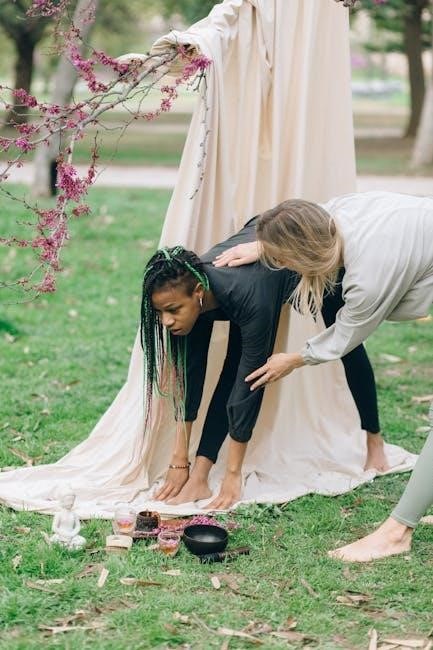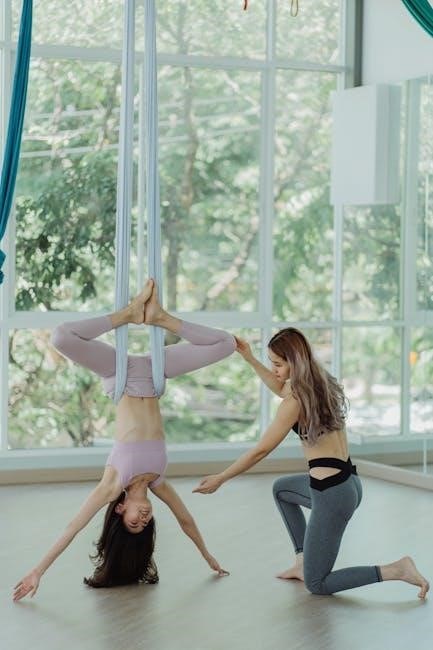Leading a guided meditation requires creating a peaceful atmosphere, setting clear intentions, and guiding participants through a structured experience. Start by preparing a calm environment, ensuring comfort and minimal distractions. Use soothing music or nature sounds to enhance relaxation. Maintain a steady, gentle tone of voice to foster trust and focus. Encourage participants to close their eyes and take deep breaths, helping them transition into a meditative state. Guide them through visualization techniques, such as imagining a serene landscape, to deepen their relaxation. Offer clear instructions for breathing and mental focus, ensuring a smooth flow from relaxation to deeper meditation. Conclude by gradually bringing participants back to awareness, ending on a positive and grounding note. Always remain empathetic and present, adapting your guidance to meet the needs of your group.
Understanding the Basics of Guided Meditation
Guided meditation is a structured practice where a leader helps participants focus their minds and relax their bodies through verbal cues, visualization, and breathing techniques. It is designed to reduce stress, improve mindfulness, and promote emotional well-being. Unlike independent meditation, guided sessions provide clear direction, making it accessible for beginners and experienced practitioners alike.
The core of guided meditation lies in its ability to create a mental escape, allowing participants to disconnect from daily worries. The leader’s role is to guide the group through a series of steps, such as grounding, relaxation, and visualization, ensuring a smooth transition into a meditative state. The practice often incorporates elements like imagery, affirmations, or body scans to deepen the experience.
Understanding the basics involves recognizing the importance of a calm environment, comfortable posture, and focused attention. Participants are encouraged to let go of distractions and fully engage with the guide’s instructions. Regular practice can enhance self-awareness, reduce anxiety, and foster a sense of inner peace. Mastery of these fundamentals is essential for both leaders and participants to maximize the benefits of guided meditation.
Preparing for the Meditation Session
Prepare a calm, distraction-free space, ensuring comfort for participants. Set a clear intention for the session and create a welcoming atmosphere with soft lighting or soothing music. Plan a structured outline or script to guide the meditation smoothly.

Setting the Intention and Creating a Conducive Environment
Setting a clear intention is vital for a focused meditation session. Determine the purpose, whether it’s stress reduction, emotional healing, or mindfulness. Communicate this intention to participants to align their expectations. Create a serene environment by ensuring a quiet, comfortable space with minimal distractions. Adjust lighting to promote relaxation, and consider using calming scents like lavender or incense. Soothing music or nature sounds can enhance the ambiance, helping participants transition into a meditative state. Encourage participants to adopt a comfortable posture, either seated or lying down, and guide them to close their eyes to internalize the experience. Establishing a peaceful atmosphere fosters a deeper connection and allows participants to fully immerse in the meditation. A well-prepared environment and clear intention lay the foundation for a transformative and meaningful guided meditation experience.
Preparing a Script or Outline for the Session
Preparing a script or outline is essential for leading a guided meditation effectively. A well-structured plan ensures the session flows smoothly and covers all desired aspects, such as relaxation, visualization, and grounding. Begin by outlining the session’s timeline, allocating time for introduction, relaxation techniques, deep meditation, and closing. Include specific prompts for breathing exercises, visualization scenarios, and affirmations to guide participants through different stages. Use clear, calming language that encourages focus and introspection. Consider the theme or goal of the meditation, such as stress relief or gratitude, and tailor your script accordingly. Incorporate cues for transitions, like gently ringing a bell or soft music, to signal shifts in the meditation. While flexibility is important, having a script prevents rambling and ensures key elements are addressed. Practice delivering the script beforehand to maintain a steady, soothing tone and pace. This preparation helps create a cohesive and impactful experience for participants, allowing them to fully engage with the meditation. A structured outline also builds confidence as a leader, enabling you to guide others effectively and compassionately.

The Role of the Meditation Leader
The meditation leader guides participants through a structured experience, creating a safe and supportive environment. They use empathy and calmness to foster connection and trust, ensuring a meaningful and transformative session for everyone involved.
Cultivating a Calm and Present Demeanor
To effectively lead a guided meditation, it’s essential to embody calmness and presence. A meditation leader’s energy sets the tone for the session, so cultivating a serene demeanor is crucial. Begin by practicing mindfulness yourself, ensuring you’re grounded before guiding others. Speak slowly and clearly, using a soothing tone that encourages relaxation. Avoid rushing through the session; instead, allow pauses for participants to fully immerse in the experience. Maintain a steady pace, guiding breathwork and visualization with gentle clarity; If nervousness arises, take a deep breath and refocus on the present moment. Your calmness will help participants feel safe and supported, fostering a deeper meditative state. Remember, your role is to create a nurturing environment, so stay attuned to the group’s energy and adapt your guidance as needed. By remaining composed and fully engaged, you’ll help participants achieve a meaningful and transformative experience.
Using Empathy and Compassion to Connect with Participants
Connecting with participants through empathy and compassion is vital for creating a meaningful guided meditation experience. As a leader, fostering a sense of safety and understanding helps participants feel supported and engaged. Begin by acknowledging the uniqueness of each individual’s journey, ensuring that your words and tone convey acceptance and kindness. Use empathetic language to validate their feelings and experiences, creating a non-judgmental space for exploration. Compassion allows you to attune to the group’s energy, offering guidance that resonates with their needs. Be present and attentive, responding to subtle cues that may indicate discomfort or resistance. Encourage participants to embrace their emotions without criticism, fostering a deeper connection to their inner selves. By embodying compassion, you create a nurturing environment where trust and openness can flourish. Remember, your role is not only to guide but also to support, ensuring every participant feels valued and empowered throughout the meditation journey.

Guiding the Meditation Session

Guide the session with a calm, steady voice, creating a soothing atmosphere. Use clear instructions and gentle pacing to help participants focus. Encourage deep breathing and visualization, allowing time for silence and reflection. Foster a sense of calm and connection throughout the experience.
Using Visualization Techniques and Imagery to Deepen the Experience
Visualization techniques and imagery are powerful tools to deepen the meditation experience. Guide participants by painting vivid mental pictures, such as imagining a peaceful landscape, like a serene beach or a tranquil forest. Encourage them to engage all senses—sight, sound, touch, and emotion—to fully immerse in the scene. For example, describe the warmth of the sun, the sound of waves, or the scent of fresh grass. This helps participants disconnect from stress and connect with their inner selves.
Use descriptive language to create a mental escape, allowing participants to explore their imagination freely. Offer gentle prompts, such as visualizing a glowing light or a protective shield, to foster a sense of safety and calm. Avoid rushing through the imagery; instead, allow silence and time for participants to absorb the experience. Encourage them to personalize the imagery, making it meaningful to their own journey. By guiding with clarity and empathy, you help participants achieve a deeper state of relaxation and inner awareness, enhancing the overall meditation experience.